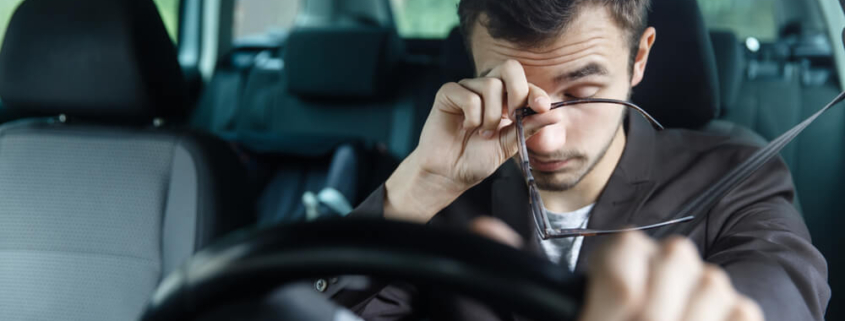How Common is Drowsy Driving?
Drowsy driving is defined as operating a motor vehicle while being too tired or fatigued to stay alert. Some of the common symptoms include continual yawning, heavy eyelids, vision becoming blurred, and the head starting to nod off. Many drivers try to combat the symptoms by blinking hard, making an extra effort to focus, turning up the radio, or rolling down the window. But despite their best efforts and willpower, they often find that their car has drifted to the side of the road or over the center line without them even realizing it.
Driving while drowsy or fatigued is an extremely dangerous practice. Being overly tired while behind the wheel impairs thinking and slows reaction times, making it more likely that the driver will cause an accident by missing important details, such as a pedestrian crossing in front of them or another vehicle entering their blind spot. In the worst cases, of course, drowsy driving can cause a driver to fall asleep behind the wheel, which most often results in catastrophic consequences.
Drowsy driving is far more common than most people believe. National Highway Transportation Safety Administration (NHTSA) numbers from a single year show that driving while drowsy was responsible for 72,000 crashes, 44,000 injuries, and 800 deaths. However, the Centers for Disease Control and Prevention (CDC) believes that these numbers are vastly underestimated, and that up to 6,000 fatal crashes per year can be attributed to drowsy drivers.
So, how common is drowsy driving? The CDC says that an estimated one out of every 25 adult drivers report that they have fallen asleep at the wheel during the past 30 days. And according to a National Sleep Foundation poll, 60% of Americans admit to having driven while sleepy, and 37% admit to having fallen asleep while behind the wheel during the past year.
The reason that the official number of drowsy driving-related crashes is far lower than what most experts estimate is because drowsiness often does not show up as a contributing factor on a police report. Think about it; when a driver is tired and nodding off at the wheel, they will wake up quickly once they collide with another vehicle or object. And once they talk to the police, there is a good chance that the driver will not admit that they were starting to get sleepy before the crash.
Who is Most Likely to Drive While Drowsy?
The truth is that at one time or another, most of us have driven when we were too tired to stay alert on the road. That said, there are certain risk factors that make this behavior more likely:
- Lack of Adequate Sleep: As you might guess, one of the leading causes of drowsy driving is not getting enough sleep. In general, this means getting six hours or less of sleep before driving. Most adults require seven hours of sleep per day to be at full capacity, and most teens require eight hours.
- Time of Day: It may also not surprise you to learn that drowsy driving is most common during the late night, overnight, and early morning hours. The body is naturally accustomed to sleeping during these hours, and drivers are more likely to get sleepy when they drive during these times of day.
- Shift Work: People who work long shifts that include lots of overtime and often run into the evening and overnight hours are more susceptible to driving while drowsy. This is especially true with those who work rotating shifts and who are unable to fully adapt to working when their body wants to be sleeping.
- Untreated Sleep Disorders: People with untreated sleep disorders such as sleep apnea are more likely to fall asleep at the wheel.
- Commercial Driving: Drowsy driving is especially common among those who drive commercially for a living, such as bus drivers, tow truck drivers, over-the-road truckers. These individuals often drive for long hours without having enough sleep, and much of their work is done during overnight hours. It is also estimated that nearly one-third of all commercial truck drivers have sleep apnea.
How Fatigue Increases Accident Rates
Fatigue has a negative impact on a driver’s ability to pay attention to the road. Since today’s drivers are more distracted than ever before, anything that makes a driver even more easily distracted is bad news for road safety. These are some of the main ways fatigue can drive up accident rates:
- Poor reaction time: Fatigue has a clear impact on your reaction time. When someone moves into your path on the road or something flies off a vehicle in front of you, even a few milliseconds of delay could cause an accident.
- Negatively affected decision-making ability: When you notice an obstacle or a change in road conditions, making the right decision is crucial. Fatigued people are less likely to make sound decisions, putting them at greater risk of causing a crash.
- Unnecessary risk-taking: Research also shows that fatigued drivers are far more likely to take unnecessary risks. They may speed far more than is reasonable, pass on the left when it isn’t clear to do so or turn without slowing down. These reckless actions make crashes a far more likely outcome.
- Impaired vision: Fatigue has been known to leave a driver’s vision cloudy and unclear, limiting their ability to see obstacles.
How to Fight Back Against Fatigue
While driver fatigue is a very serious problem across the country, the good news is that it is largely avoidable. While some will always be at a greater risk of fatigue, most people can protect themselves against this risk with a few simple tips:
- Get enough sleep: This is obvious, but its importance cannot be overstated. The night before a long drive or long day, make sure you get at least seven hours of sleep. If you know your sleep needs well, you may find that you actually need eight or nine to feel rested.
- Schedule breaks on your drive: Check your route for rest stops and other areas you can stop for a snack, a quick walk, and possibly even a nap.
- Know when you need a break: Even if you are well-rested prior to a drive, you need to stop if you find that you are getting drowsy. If you find yourself drifting out of your lane, struggling to keep your eyes open, or yawning more than usual, know that you need to take a power nap.
- Try to drive during the day more: Avoiding nighttime driving can go a long way in preventing fatigue. If at all possible, try to wrap up your drive before it gets dark.
- Use safety features on your vehicle: Features that tell you when you drift out of your lane, when your eyes aren’t on the road, or when you are driving erratically can help you know when you need a break.
Injured in a Drowsy Driving Accident in Mississippi? Contact a Seasoned Pascagoula Auto Accident Lawyer
If you or someone close to you suffered injury at the hands of a drowsy driver in Biloxi, Gulfport, Pascagoula, Ocean Springs, or anywhere in Southern Mississippi, call the Gardner Law Firm today at (228) 900-9618 or message us online for a free consultation. We will meet with you to thoroughly assess your case and advise you of your legal rights and options.




